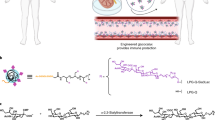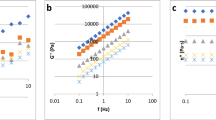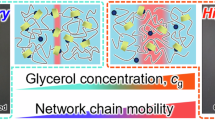Abstract
The rheological behavior of aminosaccharide-based glycopolymers prepared through the chemical modification of ethylene-vinyl alcohol copolymers was evaluated in bulk and in aqueous solution. The viscoelastic response of the polymers was assessed by conducting dynamic mechanical thermal analyses and taking rheology measurements, and information on the stiffness and relaxation mechanisms of the glycopolymers in bulk was obtained. Moreover, the development of reversible networks was observed by performing isochronal and isothermal experiments.
Similar content being viewed by others
Log in or create a free account to read this content
Gain free access to this article, as well as selected content from this journal and more on nature.com
or
References
Thoma, G., Patton, J. T., Magnani, J. L., Ernst, B., Ohrlein, R. & Duthaler, R. O. Versatile functionalization of polylysine: synthesis, characterization, and use of neoglycoconjugates. J. Am. Chem. Soc. 121, 5919–5929 (1999).
Okada, M. Molecular design and syntheses of glycopolymers. Prog. Polym. Sci. 26, 67–104 (2001).
Varki, A. Biological roles of oligosaccharides—all of the theories are correct. Glycobiology 3, 97–130 (1993).
Dwek, R. A. Glycobiology: toward understanding the function of sugars. Chem. Rev. 96, 683–720 (1996).
Choi, S. K., Mammen, M. & Whitesides, G. M. Generation and in situ evaluation of libraries of poly(acrylic acid) presenting sialosides as side chains as polyvalent inhibitors of influenza-mediated hemagglutination. J. Am. Chem. Soc. 119, 4103–4111 (1997).
Roy, R. & Baek, M. G. Glycodendrimers: novel glycotope isosteres unmasking sugar coding. Case study with T-antigen markers from breast cancer MUC1 glycoprotein. Rev. Mol. Biotechnol. 90, 291–309 (2002).
Fleming, C., Maldjian, A., Costa, D. D., Rullay, A. K., Haddleton, D. M., St John, J., Penny, P., Noble, R. C., Cameron, N. R. & Davis, B. G. A carbohydrate-antioxidant hybrid polymer reduces oxidative damage in spermatozoa and enhances fertility. Nat. Chem. Biol. 1, 270–274 (2005).
Garcia-Martin, M. G., Jimenez-Hidalgo, C., Al-Kass, S. S. J., Caraballo, I., De Paz, M. V. & Galbis, J. A. Synthesis and characterization of some new homo- and copoly(vinylsaccharides). Some preliminary studies as drug delivery. Polymer 41, 821–826 (2000).
Roche, A. C., Fajac, I., Grosse, S., Frison, N., Rondanino, C., Mayer, R. & Monsigny, M. Glycofection: facilitated gene transfer by cationic glycopolymers. Cell Mol. Life Sci. 60, 288–297 (2003).
Yun, Y. H., Goetz, D. J., Yellen, P. & Chen, W. Hyaluronan microspheres for sustained gene delivery and site-specific targeting. Biomaterials 25, 147–157 (2004).
Palomino, E. Carbohydrate handles as natural-resources in drug-delivery. Adv. Drug Deliv. Rev. 13, 311 (1994).
Wadhwa, M. S. & Rice, K. G. Receptor-mediated glycotargeting. J. Drug Target. 3, 111–127 (1995).
Sihorkar, V. & Vya, S. P. Potential of polysaccharide anchored liposomes in drug delivery, targeting and immunization. J. Pharm. Pharm. Sci. 4, 138–158 (2001).
Dickinson, E. & Bergenstahl, B. in Food Colloids: Proteins, Lipids and Polysaccharides Vol. 192, pp. 417 (The Royal Society of Chemistry, Cambridge, 1997).
Novick, S. J. & Dordick, J. S. Preparation of active and stable biocatalytic hydrogels for use in selective transformations. Chem. Mat. 10, 955–958 (1998).
Wulff, G., Zhu, L. & Schmidt, H. Investigations on surface-modified bulk polymers. 1. Copolymers of styrene with a styrene moiety containing a sugar monomer. Macromolecules 30, 4533–4539 (1997).
Wulff, G., Schmidt, H. & Zhu, L. Generating hydrophilic surfaces on standard polymers after copolymerization with low amounts of protected vinyl sugars. Macromol. Chem. Phys. 200, 774–782 (1999).
Karamuk, E., Mayer, J., Wintermantel, E. & Akaike, T. Partially degradable film/fabric composites: textile scaffolds for liver cell culture. Artif. Organs 23, 881–884 (1999).
Nitta, Y. & Nishinari, K. Gelation and gel properties of polysaccharides gellan gum and tamarind xyloglucan. J. Biol. Macromol. 5, 47–52 (2005).
Kavanagh, G. M. & Ross-Murphy, S. B. Rheological characterisation of polymer gels. Prog. Polym. Sci. 23, 533–562 (1998).
Peppas, N. A. Hydrogels in Medicine and Pharmacy Vol. 1 (CRC Press, Boca Raton, FL, 1986).
Dunn, A. S. in: Polyvinyl Alcohol-Developments (ed. Finch, C.A.) 217 (John Wiley and Sons, London, 1992).
Takahashi, A. & Hiramits, S. Melting temperature of a thermally reversible gel. 3. Poly(vinyl alcohol)-water gels. Polym. J. 6, 103–107 (1974).
Rogozhin, S. V., Lozinskii, V. I., Vainerman, E. S., Domotenko, L. V., Mamtsis, A. M., Ivanova, S. A., Shtilman, M. I. & Korshak, V. V. Non-covalent cryostructurization in polymer systems. Dokl Akad Nauk USSR 278, 129–133 (1984).
Yamaura, K., Itoh, M. & Matsuzawa, S. Properties of gels obtained by freezing-thawing of poly(vinyl-alcohol) water dimethyl-sulfoxide solutions. J. Appl. Polym. Sci. 37, 2709–2718 (1989).
Cha, W. I., Hyon, S. H. & Ikada, Y. Transparent poly(vinyl alcohol) hydrogel with high water-content and high-strength. Makromol. Chem. 193, 1913–1925 (1992).
Ohkura, M., Kanaya, T. & Kaji, K. Gels of poly(vinyl alcohol) from dimethyl-sulfoxide water solutions. Polymer 33, 3686–3690 (1992).
Kanekiyo, M., Kobayashi, M., Ando, I., Kurosu, H. & Amiya, S. Structural and dynamic study of ethylene-vinyl alcohol copolymer gels by H-1 pulse NMR and solid-state C-13 NMR. Macromolecules 33, 7971–7976 (2000).
Ruiz, C., Sánchez-Chaves, M., Cerrada, M. L. & Fernández-García, M. Glycopolymers resulting from ethylene-vinyl alcohol copolymers: synthetic approach, characterization and interactions with lectins. J. Polym. Sci. Part A Polym. Chem. 46, 7238–7248 (2008).
Cerrada, M. L., Sánchez-Chaves, M., Ruiz, C. & Fernández-García, M. Glycopolymers resultant from ethylene-vinyl alcohol copolymers: degradation and rheological behavior in bulk. Eur. Polym. J. 44, 2194–2201 (2008).
Mc Crum, N. G., Read, B. E. & Williams, G. Anelastic and Dielectric Effects in Solid Polymers (Dover, New York, 1991).
Sánchez-Chaves, M., Ruiz, C., Cerrada, M. L. & Fernández-García, M. New glycopolymers containing aminosaccharide pendant groups by chemical modification of ethylene vinyl alcohol copolymers. Polymer 49, 2801–2807 (2008).
Lee, R. T., Ichikawa, Y., Fay, M., Drickamer, K., Shao, M. C. & Lee, Y. C. Ligand-binding characteristics of rat serum-type mannose-binding protein (mbp-a)-homology of binding-site architecture with mammalian and chicken hepatic lectins. J. Biol. Chem. 266, 4810–4815 (1991).
Lee, Y. C. & Lee, R. T. Carbohydrate-protein interactions: basis of glycobiology. Acc. Chem. Res. 28, 321–327 (1995).
Miura, Y., Ikeda, T., Wada, N., Sato, H. & Kobayashi, K. Chemoenzymatic synthesis of glycoconjugate polymers: greening the synthesis of biomaterials. Green Chem. 5, 610–614 (2003).
Matsuura, K., Hibino, M., Ikeda, T., Yamada, Y. & Kobayashi, K. Self-organized glycoclusters along DNA: effect of the spatial arrangement of galactoside residues on cooperative lectin recognition. Chemistry 10, 352–359 (2004).
Matsuura, K., Oda, R., Kitakoji, H., Kiso, M., Kitajima, K. & Kobayashi, K. Surface plasmon resonance study of carbohydrate-carbohydrate interaction between various gangliosides and Gg3-carrying polystyrene. Biomacromolecules 5, 937–941 (2004).
Kitov, P. I., Shimizu, H., Homans, S. W. & Bundle, D. R. Optimization of tether length in non-glycosidically linked bivalent ligands that target sites 2 and 1 of a Shiga-like toxin. J. Am. Chem. Soc. 125, 3284–3294 (2003).
Yung, A., Turnbull, W. B., Kalverda, A. P., Thomson, G. S., Homans, S. W., Kitov, P. & Bundle, D. R. Large-scale millisecond intersubunit dynamics in the B subunit homopentamer of the toxin derived from Escherichia coli O157. J. Am. Chem. Soc. 125, 3058–13062 (2003).
Sánchez-Chaves, M., Arranz, F. & Cortazar, M. Poly(vinyl alcohol) functionalized by monosuccinate groups. Coupling of bioactive amino compounds. Polymer 39, 2751–2757 (1998).
Takae, S., Akiyama, Y., Otsuka, H., Nakamura, T., Nagasaki, Y. & Kataoka, K. Ligand density effect on biorecognition by PEGylated gold nanoparticles: regulated interaction of RCA(120) lectin with lactose installed to the distal end of tethered PEG strands on gold surface. Biomacromolecules 6, 818–824 (2005).
Cerrada, M. L., Benavente, R., Pérez, E. & Pereña, J. M. The effect of annealing on the structure and relaxation processes of vinyl alcohol-ethylene copolymers. J. Polym. Sci. Part B Polym. Phys. 39, 1–12 (2001).
Cerrada, M. L., Pereña, J. M., Benavente, R. & Pérez, E. Viscoelastic processes in vinyl alcohol-ethylene copolymers. Influence of composition and thermal treatment. Polymer 41, 6655–6661 (2000).
Garrett, P. D. & Grubb, D. T. Effect of drawing on the alpha-relaxation of poly(vinyl-alcohol). J. Polym. Sci. Part B Polym. Phys. 26, 2509–2523 (1998).
Hong, P. D. & Miyasaka, K. Drawing of poly(vinyl alcohol) gel films. Polymer 32, 3140–3146 (1991).
Heaton, N. J., Benavente, R., Pérez, E., Bello, A. & Pereña, J. M. The gamma relaxation in polymers containing ether linkages: conformational dynamics in the amorphous phase for a series of polybibenzoates containing oxyethylene spacers. Polymer 37, 3791–3798 (1996).
Hirrien, M., Chevillard, C., Desbrières, J., Axelos, M. A. V. & Rinaudo, M. Thermogelation of methylcelluloses: new evidence for understanding the gelation mechanism. Polymer 39, 6251–6259 (1998).
Acknowledgements
The financial support of Ministerio de Ciencia e Innovación (Project MAT2007-60983) is gratefully acknowledged.
Author information
Authors and Affiliations
Corresponding author
Rights and permissions
About this article
Cite this article
Cerrada, M., Ruiz, C., Sánchez-Chaves, M. et al. Rheological behavior of aminosaccharide-based glycopolymers obtained from ethylene-vinyl alcohol copolymers. Polym J 43, 205–213 (2011). https://doi.org/10.1038/pj.2010.128
Received:
Revised:
Accepted:
Published:
Issue date:
DOI: https://doi.org/10.1038/pj.2010.128



